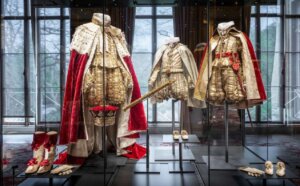On Sunday we dropped in for a quick visit to Apsley House on our way to dance at the Argentine Ambassador’s Residence (as you do). Someone at English Heritage had said that we had to see the Duke’s robes, which were on display there and which had been worn at the coronation of Charles III.
I always do what I’m told, so we duly went in to gawp. Apsley House doesn’t allow photography but they have an excellent picture on their website:

The robes are interesting to me, not because they were worn by the current duke, but because they were worn by the Iron Duke at the coronation of George IV in 1821.
The robes say something about the whole ceremony of crowning the new monarch, which was true then and now. The robes worn in 1821 were not some traditional costume handed down through the centuries, but had been specially designed for the occasion. Say what you like about the Georgians, but they knew how to put on a spectacle. In this case, they decided that the robes should be designed in the style of Tudor and early Stuart dress to create an impression that these were ancient finery and that the ceremony was a continuation of a rich tradition. It was a “tradition” that the Georgians were anxious to emphasise as, in fact, their claim to the throne hung by a slender thread. (When you are next told that the king traces his ancestry back to Alfred, you might reasonably ask why his family is German.) It is a similar perceived need to appeal to ancient traditions that saw these early 19th century robes taken out of mothballs for a 2023 ceremony. In fact, we were repeatedly assured by the BBC that this ceremony was essentially unchanged in a thousand years. I wonder what people would have made of it had it been conducted in Norman French and Latin.
What did the first Duke of Wellington (a man famously thrown out of his club for wearing trousers instead of breeches) make of this fancy dress? He is on record as having said he thought it was ridiculous but seeing how the spectacle was received by the thousands of spectators he admitted that the magnificence of the display achieved the required effect.
Two hundred years later, it seems that this aspect the ceremony, at least, is following an established tradition.

What a wonderful thought provoking post! It reminds me of the old medieval chronicles where they loved to write long rambling genealogies to show the legitimacy of the current monarch by tracing their bloodlines back through Woden (Odin) to Romulus and Remus and then finishing off at the royal family of Troy. I believe Geoffrey of Monmouth was particularly fond of doing this.